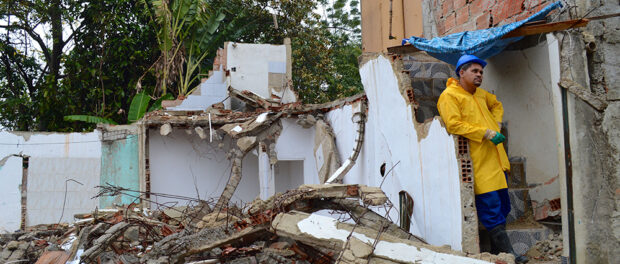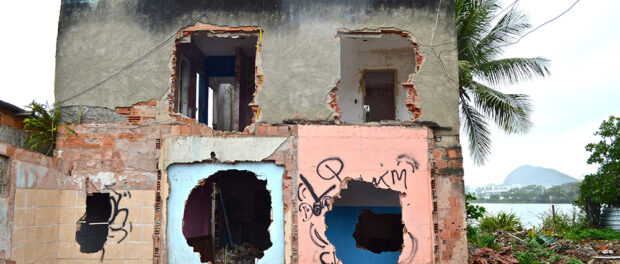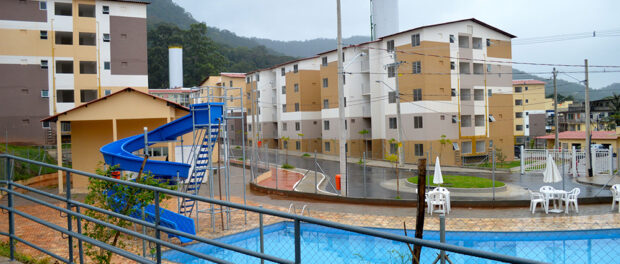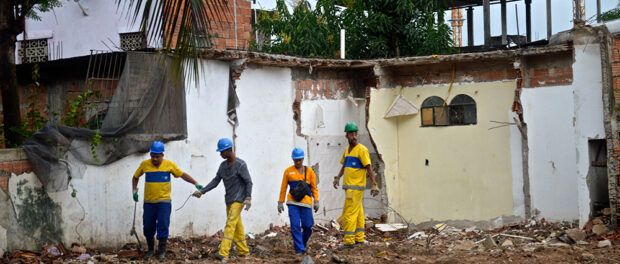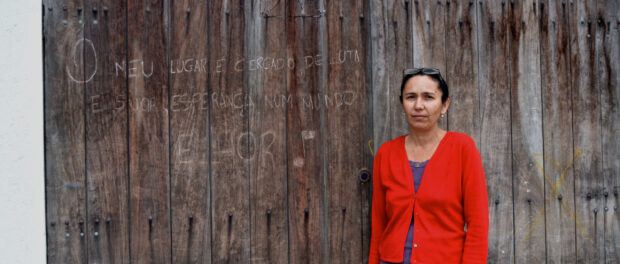
“O meu lugar,
É cercado de luta e suor,
Esperança num mundo melhor”
“My place,
It is surrounded by struggle and sweat,
Hope for a better world”
Maria do Socorro’s 14-year-old daughter wrote these lyrics on her garage door, looking on and crying as the adjacent house was violently torn down, signaling the departure of her friend and neighbor. It was April, the beginning of long-feared housing demolitions in Vila Autódromo, and a buzz of journalists and photographers were documenting the scene. Several climbed Maria’s outdoor stairway for a better view of the destruction; kitchen tiles shattered by sledgehammers, metal wires mangled, drilling equipment piercing through walls, and finally, a bulldozer flattening what was left of the skeletal structure.
The demolitions have continued systematically in Vila Autódromo for several months. By residents’ own estimates, up to half the families have left the community, the majority opting for resettlement in the Parque Carioca housing complex and the rest accepting financial compensation.
Activists assert the city is imposing unbearable conditions upon those families who remain and continue to resist. Many have been without regular water and electricity for months. Maria has stopped receiving phone and Internet service, and says the city even tried to remove the community’s public telephones. Last weekend, the city constructed a temporary partition wall down the main access road (supposedly for construction works), severely limiting residents’ mobility and blocking access to the children’s playground. Many residents argue that the relentless demolition of homes is intended to exhaust the resistance efforts by creating a climate of fear, uncertainty, and despair.
“They kill you bit by bit,” Maria noted. “They tear down your neighbor’s house, they pass in front of your house with a bulldozer breaking things. This is how they carry on, devastating and demolishing.”
“Ghost Town”
José Arimateia is a 30-year resident of the community and owner of the local bakery. His successful business is putting two children through college. After years of resistance, José has evidently been worn out.
“There is no hope left and it is sad,” he said, adding that the once lively and peaceful community now feels like a “ghost town.”
The streets are deserted on this day, except for construction workers circulating through partially demolished houses and piles of rubble. Empty lots and abandoned furniture leave an ominous and foreboding feeling. Though only a fraction of homes have been demolished, this appears to have had an effect on the community psyche. Bulldozers roll through the streets like war tanks and demolition crews have marked their permanence by setting up offices in containers at the community entrance.
During a recent visit to Vila Autódromo, the prevailing feeling was that residents were “just waiting,” whether it be for information, water, or another round of negotiations with the city.
The dream of staying
Through multiple rounds of negotiation with the city, families are demonstrating their refusal to accept undervalued sums for their homes, titled two decades ago by the State government. José has asked for 1.3 million reais, market rate compensation for his home and bakery, his family’s only source of income. To date, he has been offered less than half that sum and is waiting for the city’s counter offer.
Maria recalls that the Municipal Secretary of Housing tried to convince her that with the proposed compensation she could buy a “dream mansion” in the Recreio area, slightly further West.
“No sir!” she replied, “That is not my dream. My dream is to stay here in my house and your dream is to get me out of it!”
Despite this resistance, in the face of a well-documented sequence of constantly shifting rationales for removal, the coercion continues. City officials repeatedly tried to intimidate Maria by saying: “Well, I am not threatening you, but if this goes to a legal battle, it will be much worse.”
Resisting Until the End
Maria and her husband moved to Vila Autódromo 17 years ago and began building their life with great difficulty. She is committed to staying in Vila Autódromo, as per her legal right and the Mayor’s affirmation last year that no one will be forced out. But she is also scared and frustrated.
“We still haven’t accepted [the city’s proposed compensation] but we are afraid because at night it feels very strange here, with all the people leaving and houses being torn down.”
Maria has asked their second-floor tenant—who has already made rental arrangements in another community—to continue living with them so that Maria’s teenage daughter will not be alone in the house when she and her husband are working.
Maria is also scared about the insecurity of these negotiations, particularly after the injunction that prevented housing demolitions was overturned in a highly controversial move from within the Public Defender’s office. Internal tensions and conflicting information have exacerbated mistrust and uncertainty.
“So what do I do? Who am I going to trust? What guarantees do I have?” she asks. “The Public Defender says we don’t have to leave if we don’t want to. But no one can guarantee to me what the Mayor is going to do. He is very Machiavellian, he says one thing and then does another.”
Maria is on the verge of tears as she imagines her family waking up to a bulldozer at their door and an official informing them that the only remaining options are Parque Carioca or becoming homeless.
A New Home
Meanwhile, former Vila Autódromo residents have started building a new community in the Parque Carioca apartment complex, located one kilometer away. Marivaldo de Jesus Silva walks me through the housing complex, passing out fliers to neighbors about the city-sponsored “Reunião de Esclarecimento” (Clarifying Meeting) that will take place the following morning. He chats up neighbors and reprimands children for locking their bicycles up along the pedestrian walkway. We joke that he should run for a leadership position in the complex, one of the topics of the upcoming meeting.
A few months ago in Vila Autódromo, Marivaldo expressed ambivalence about the resettlement housing and was waiting for certain rumors to be cleared up before moving with his 5-year-old daughter. Now, he says he has no regrets about his decision.
“There were a lot of struggles [in Vila Autódromo] over the years and it is tiring. People were exhausted living there without any infrastructure, which caused various problems in their day-to-day life. So the people resolved to move and everything is good here, thank God.”
Although Marivaldo has had a positive experience, opinions about the Parque Carioca housing are mixed. Maria do Socorro explains that several former neighbors she has visited regret their decision due to high utility costs, including electric bills upwards of 200 reais per month.
Despite O Globo newspaper’s glossy photos of children splashing around in the communal swimming pool, Parque Carioca looks and feels like a heavily surveilled public housing project. Identical apartment blocks extend off a central road, each with its own gated entrance and security guard. Visitors can only enter if accompanied by a resident, in contract with Vila Autódromo, where residents often boasted, “Here anyone can come and go any time of day or night,” in reference to both safety and welcoming of outsiders.
As I was toured around by Marivaldo, a city representative drove up and inquired who I was and why I was taking photos.
The Final Hope
Back in Vila Autódromo, the resistance continues as leaders pressure the Mayor to release the promised upgrading plans for the families that will remain. The Mayor maintains that he cannot publicize the plan until the families wishing to leave have done so, which many residents assert is a convenient excuse to obscure his true intentions and increase the climate of fear and uncertainty about the community’s future, increasing chances of further capitulation under pressure.
“It’s all maquiagem (make-up),” José explained. “I knew from the beginning that his plan was to do away with the entire community.”
Families continue to resist in diverse ways. Many are holding weekly meetings to strengthen resistance efforts and demand accountability in this moment of intense pressure from the city. Others remain strong in the face of an asymmetrical and often coercive negotiation process, receiving some of the first market-rate compensation of favela homes in the city’s history. Others are carving out a new life and community for themselves in Parque Carioca housing, welcoming the stability after years of struggle and uncertainty.
Maria’s parting words to me are in the same spirit of determination that has fortified Vila Autódromo over decades.
“My hope is that we are still living here the next time you come to visit,” she tells me.
Slideshow with images of Vila Autódromo street life, existing houses and undergoing demolition in April, and Parque Carioca:
Created with Admarket’s flickrSLiDR.
Slideshow with images of Vila Autódromo demolitions, July 2014:
Created with Admarket’s flickrSLiDR.

